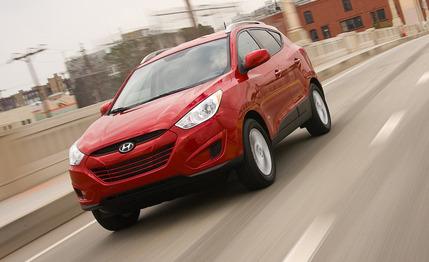
 Short Take Road Test
Short Take Road Test


On the fun scale, a small SUV ranks in appeal alongside an extended stay at the Guantanamo Inn. But such vehicles have their place, and the annual sales numbers of small SUVs prove that. Young families love their affordability and cargo room, and empty nesters love their ease of ingress and egress and, yes, cargo room. And everyone likes that small SUVs typically offer good sightlines and a plush ride.
Take the Hyundai Tucson, for example, a vehicle we said was Hyundai’s best impression of a Honda CR-V. It has most of those virtues, with value perhaps ranking highest; our GLS tester came in under 20 grand by a Benjamin and a Hamilton. Moreover, the Tucson boasts above-average passenger space, decent ride behavior, sensible fuel economy, and a standard manual transmission.
More Pedals, Less Money


Yup, that’s right. Hyundai gives the public a shift-it-yourself option in its newest SUV, something Honda does not with the CR-V. The shifter in this GLS might not be as smooth as we’d like, and the clutch engagement is what we refer to as an “idiot clutch” (meaning even a novice can get the vehicle moving), but let’s award points for Hyundai’s installing a manual at all. A few other makers offer stick shifts in this class (the Ford Escape, the Mazda Tribute, the Kia Sportage, the Volkswagen Tiguan, the Suzuki Grand Vitara, the Subaru Forester), but only the Sportage starts below the Tucson’s $19,790 base price. And only the $24,000 Tiguan offers a six-speed stick like the Tucson’s.
The manual-equipped Tucson is exclusively front-wheel drive (and has no available options, but we’ll get to that). The upsides to front-wheel drive in this case are a slightly trimmer curb weight—3176 pounds versus 3382 for the all-wheel-drive Tucson—and significantly better real-world fuel economy. The EPA numbers are close, with the front-drive Tucson rated for 22 mpg city and 30 mpg highway versus 21/28 for the AWD model. But we averaged 17 mpg in a Tucson GLS AWD, significantly lower than the 23 mpg we got from this manual front-driver. For the thrifty shoppers in this segment, that’s not insignificant. We also recorded much better acceleration times with the manual Tucson. All Tucsons have a 176-hp, 2.4-liter inline-four, and the engine convinced this front-drive example to hit 60 mph in 8.1 seconds, 0.5 second better than the AWD model, thanks to the front-driver’s allowing more wheelspin off the line. The skidpad results, however, favor the all-wheel-drive model, which turned in 0.81 g versus the front-driver’s 0.76. The latter Tucson’s open front differential is constantly attempting to divert power to the inside wheel—the one with less grip—creating a one-tire fire. The same thing can happen around town if you’re not judicious with the throttle.
Otherwise, this Tucson is pleasant to drive. The steering is nicely weighted, the ride is refined and somewhat sporty, and the whole vehicle feels solid and well built.
Pack Smart
One place the Tucson falls short, however, is cargo capacity. Leaders in the small-SUV segment top 70 cubic feet of maximum cargo space, but the Tucson can only accept 56 cubes with the rear seat folded, and the total drops to 26 with the seat up. We also weren’t fans of some hard plastics in the interior, and if you get the manual Tucson, there’s nothing you can do about them, since there are no options beyond dealer-installed items such as cargo trays and carpeted floor mats. Step up to the auto for $1000 more, though, and you can spec the $1700 Popular Equipment package that dresses up the cabin with leatherette upholstery, leather on the steering wheel and shifter, and soft-touch interior surfaces. It also nabs alloy wheels, Bluetooth connectivity, cruise control, and heated side mirrors, among other stuff. Navigation is an option with the automatic.
It’s not as if you forgo all modern conveniences with the manual transmission. Power windows and locks, keyless entry, XM satellite radio, iPod and auxiliary audio connections, air conditioning, and stability control are among the standard equipment. But if a fancy Tucson is what you want, you’ll have to let the thing shift for itself. And then you’d miss out on executing perfect heel-and-toe downshifts in your small SUV. And, really, isn’t that worth the sacrifice?